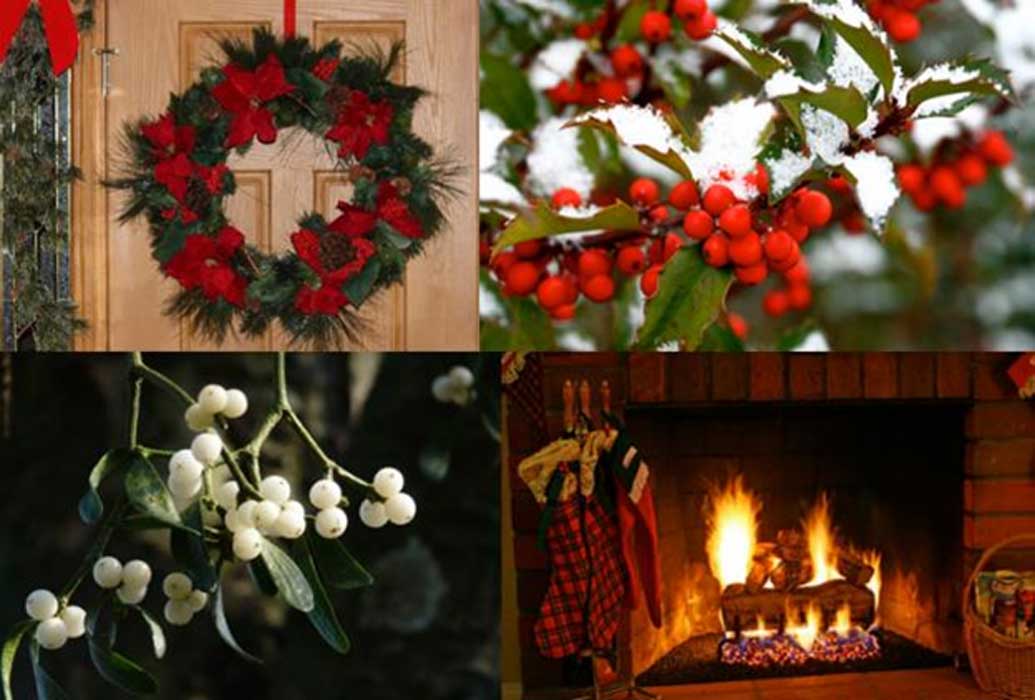Mistletoe, Holly, and Yuletide Cheer: Weaving Nature into Ancient Christmas Customs
It is estimated 2 billion people celebrate Christmas each year. Although the popular holiday is linked to Christianity and the birth of Jesus Christ, people all over the world, Christians or not, have embraced this tradition in ever-increasing numbers. Perhaps this is due, in part, to the universal appeal of customs which have been incorporated into Christmas. You may be surprised to discover that several natural elements which appear at Christmas do not have their roots in Christianity.
A Welcoming Christmas Wreath
A wreath is a common feature on the front door of many homes around Christmas time. It is a piece of nature which adds an added touch of Christmas cheer, but the meaning of this decoration runs much deeper than festive felicitations. The wreath is a powerful and ancient symbol of the unending cycle of life as well as victory and honor. Evergreen branches were crafted into wreaths by Druids, Celts, and Romans during their winter solstice celebrations. By 1444, wreaths had become Christmas decorations found all over London and in the 16th century, Germans had united the circular-shaped evergreen branches with god's love, something said to have no beginning or end.

A door decorated with a Christmas wreath. (JamesDeMers/CC0)
Holy Holly Ancient Christmas Customs
Several groups of ancient people believed including beautiful green foliage in your home during wintertime and completing ceremonies with it would ensure the regrowth of vegetation outside in the spring. Holly was preferred by some for its shiny leaves and its ability to bear fruit in winter – aspects which made it seem almost magical. Holly syrup was used to cure coughs and holly leaves were hung over beds to encourage good dreams. Romans gifted the plant in their Saturnalia festivities.
- A Tradition Revived? Inverted Christmas Trees May Have Pagan Roots
- Christkind: How Does this Christmas Gift-Bringer Differ from Santa Claus?
When Christians decided to celebrate the birth of Jesus Christ in December, it coincided with Saturnalia. Decorating their homes with holly helped the Christians avoid detection and persecution. The early Christian church also used holly as a symbol of Christ's crucifixion. One legend claims Christ's crown of thorns was made out of holly. The story says holly berries were originally white, but were stained red by Christ's blood. The sharply pointed holly leaves became seen as symbols of the thorny crown and the red berries drops of Christ’s blood.

Snowy holly. (liz west/CC BY 2.0)
Merry-Met Under the Mistletoe
Druids and Romans both held mistletoe in high regard. These groups believed that the plant had healing powers and could ward off evil. Mistletoe was seen as a connection between earth and the heavens because it grew without roots. It was also a symbol of peace – stories tell of soldiers holding a temporary truce if they met their enemies under mistletoe. Ancient Britons thought that hanging mistletoe at their door would keep evil from it. Anyone who was able to cross the threshold safely received a welcome kiss, thus starting the Christmas tradition of kissing under the mistletoe.

Mistletoe. (CC0)
Keeping the Yule Log Burning
People in many European countries light a Yule log at Christmas time. They also serve cakes shaped like the logs and call them Yule cakes. The Christmas celebration is sometimes even called Yule, from the Scandinavian word Juul, the name of a winter solstice feast.
- The Medieval Origins of The Carol: How Christmas Songs Have Survived Through the Centuries
- Krampus, Son of Hel: The Ancient Origins of the Christmas Devil

A Yule cake. (Jebulon/CC0)
After thirty-five of dark days in the Scandinavian winter, scouts would head to mountain tops and await the return of the sun. Upon the first light, the scouts would hurry back to their villages and share the good news. A Yuletide festival commenced with the glad tidings and a special feast was held around a Yule log fire. Celebrations continued until the log turned to ash. The Yule log also served to honor the god Thor because ancient Scandinavians believed their homes were safe from Thor's lightning bolts as long as the burnt Yule was present in their homes.

A yule bonfire is an ancient Christmas custom originated in Nordic countries. (brian colson/flickr)
Celts, Teutons and Druids also burned massive logs in winter solstice ceremonies to celebrate the sun. As Christianity gained power in Europe, the Yule log stayed popular in England and Scandinavia. Church authorities permitted the ritual when they changed its meaning – the light of the Yule fire became associated with the light that came from Heaven when Christ was born. Following this change, a Yule log would be lit on Christmas Eve and burned throughout the twelve days of Christmas.
Top Image: Ancient Christmas customs still held today. A door decorated with a Christmas wreath. (CC0) Snowy holly. (liz west/CC BY 2.0) Mistletoe. (CC0) A Yuletide fireplace. (Randy Robertson/CC BY 2.0)

















